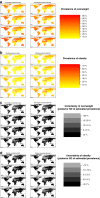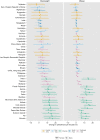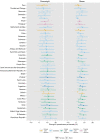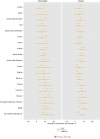National, regional, and global trends in adult overweight and obesity prevalences
- PMID: 23167948
- PMCID: PMC3543235
- DOI: 10.1186/1478-7954-10-22
National, regional, and global trends in adult overweight and obesity prevalences
Abstract
Background: Overweight and obesity prevalence are commonly used for public and policy communication of the extent of the obesity epidemic, yet comparable estimates of trends in overweight and obesity prevalence by country are not available.
Methods: We estimated trends between 1980 and 2008 in overweight and obesity prevalence and their uncertainty for adults 20 years of age and older in 199 countries and territories. Data were from a previous study, which used a Bayesian hierarchical model to estimate mean body mass index (BMI) based on published and unpublished health examination surveys and epidemiologic studies. Here, we used the estimated mean BMIs in a regression model to predict overweight and obesity prevalence by age, country, year, and sex. The uncertainty of the estimates included both those of the Bayesian hierarchical model and the uncertainty due to cross-walking from mean BMI to overweight and obesity prevalence.
Results: The global age-standardized prevalence of obesity nearly doubled from 6.4% (95% uncertainty interval 5.7-7.2%) in 1980 to 12.0% (11.5-12.5%) in 2008. Half of this rise occurred in the 20 years between 1980 and 2000, and half occurred in the 8 years between 2000 and 2008. The age-standardized prevalence of overweight increased from 24.6% (22.7-26.7%) to 34.4% (33.2-35.5%) during the same 28-year period. In 2008, female obesity prevalence ranged from 1.4% (0.7-2.2%) in Bangladesh and 1.5% (0.9-2.4%) in Madagascar to 70.4% (61.9-78.9%) in Tonga and 74.8% (66.7-82.1%) in Nauru. Male obesity was below 1% in Bangladesh, Democratic Republic of the Congo, and Ethiopia, and was highest in Cook Islands (60.1%, 52.6-67.6%) and Nauru (67.9%, 60.5-75.0%).
Conclusions: Globally, the prevalence of overweight and obesity has increased since 1980, and the increase has accelerated. Although obesity increased in most countries, levels and trends varied substantially. These data on trends in overweight and obesity may be used to set targets for obesity prevalence as requested at the United Nations high-level meeting on Prevention and Control of NCDs.
Figures









References
-
- Ni Mhurchu C, Rodgers A, Pan WH, Gu DF, Woodward M. Body mass index and cardiovascular disease in the Asia-Pacific Region: an overview of 33 cohorts involving 310 000 participants. Int J Epidemiol. 2004;33:751–758. - PubMed
-
- Whitlock G, Lewington S, Sherliker P, Clarke R, Emberson J, Halsey J, Qizilbash N, Collins R, Peto R. Body-mass index and cause-specific mortality in 900 000 adults: collaborative analyses of 57 prospective studies. Lancet. 2009;373:1083–1096. doi: 10.1016/S0140-6736(09)60318-4. - DOI - PMC - PubMed
-
- World Health Organization. Global health risks: Mortality and burden of disease attributable to selected major risks. Geneva: World Health Organization; 2009.
-
- Wormser D, Kaptoge S, Di Angelantonio E, Wood AM, Pennells L, Thompson A, Sarwar N, Kizer JR, Lawlor DA, Nordestgaard BG. et al.Separate and combined associations of body-mass index and abdominal adiposity with cardiovascular disease: collaborative analysis of 58 prospective studies. Lancet. 2011;377:1085–1095. - PMC - PubMed
Grants and funding
LinkOut - more resources
Full Text Sources
Other Literature Sources
Medical

